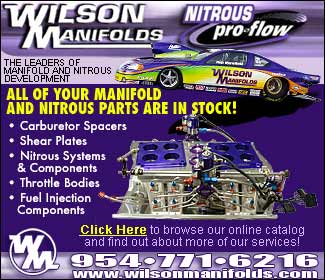| NITRO
SPONSORSHIPS
By Frank Oglesby
12/13/05
 said in my last Nitro Funny Car feature that we would be discussing
“sponsorship” in drag racing-- though I believe
"sponsorship" is a misnomer which sounds more like
philanthropy rather than what it really is - a marketing partnership.
"Sponsor" is the word commonly used so I have no
choice but to use it as well.
said in my last Nitro Funny Car feature that we would be discussing
“sponsorship” in drag racing-- though I believe
"sponsorship" is a misnomer which sounds more like
philanthropy rather than what it really is - a marketing partnership.
"Sponsor" is the word commonly used so I have no
choice but to use it as well.
Let’s begin by reviewing how it was in the Nitro Funny
Car class just before sponsors came on the scene, how that
has changed and what the current situation is.
ADVERTISEMENT
 |
The
factories were involved from the beginning and there was product
support as well, but the major turning point in the sponsorship
story was the McEwen/Prudhomme Mattel “Hot Wheels”
program of 1970. This was the first real effort to use the
marketing abilities of a Nitro Funny Car by a non-automotive
Fortune 500 company.
The Mattel program was significant for another reason as
well. During the non-sponsored era Nitro FC’s income
came solely from match racing and by the late '60s team ownership
had broken into two different groups. Group one were tuners
and/or drivers who now owned and operated their own race teams.
This group was all talent and no money other than match race
income. The second group was wealthy owners either from other
business interests or inheritance that had to hire talent
to run their teams.
The funny part is both groups ran about the same on the match
race circuit, as the wealthy owners couldn’t hire the
top talent because they were busy running their own teams.
The few national events at the time were another matter.
The better funded teams had the advantage because of having
four runs to get it right (qualify) and the parts to burn
up if need be. The Hot Wheels deal changed all that forever
as Prudhomme was a “racer’s racer” and for
the first time the talent had the money to spend on what was
important in order to win. Don spent the money wisely and
the Mattel sponsorship leads to his Army sponsorship which
changed Nitro Funny Car racing forever. During Don’s
Army sponsored days he proved without a doubt when the “Talent”
had the money you either had to join the parade or be left
behind.
This era (about '73 to '83) was the owner/driver/business
man looking for sponsorship opportunities in order to run
the national events, both IHRA and NHRA. Basically the teams
that were successful in acquiring a sponsor ran national events
and those that didn’t continued to match race as it
was still possible to make a living in that venue at the time.
Looking for marketing partners was quite different from today.
Drag racing was far from the mainstream and a really hard
sell but we did have a couple of advantages, NASCAR was not
the 800 lb gorilla it is today and perhaps as importantly
both IHRA and NHRA needed Nitro FC teams to have sponsors
to insure a full field because then, as now, the purse didn’t
pay enough to even begin to cover the cost of fielding a nitro
team.
Being sure of a full field was much harder for both sanctioning
bodies at the time as the teams still had match racing to
fall back on. Neither IHRA nor NHRA owned that many tracks
nor did they run the number of events they run today. These
facts caused them to be MUCH easier to get along with.
Many of the nitro teams who got their start during this period
still own teams today. The other team owners who, for whatever
reason, failed to keep the necessary funding have either left
the sport or finished out their careers as employees of the
new breed of business men/team owners.
By the early ’90s, for reasons outside the scope of
this article, the cost to run a nitro car had skyrocketed
and the number of national events had grown to the point nitro
match racing was just a memory. At about the same time, IHRA
dropped the Nitro Funny car class, the most popular class
in drag racing history by about a two-to-one margin. (If that
was not the worst marketing decision in motorsports ever,
it is certainly in the running.)
|
